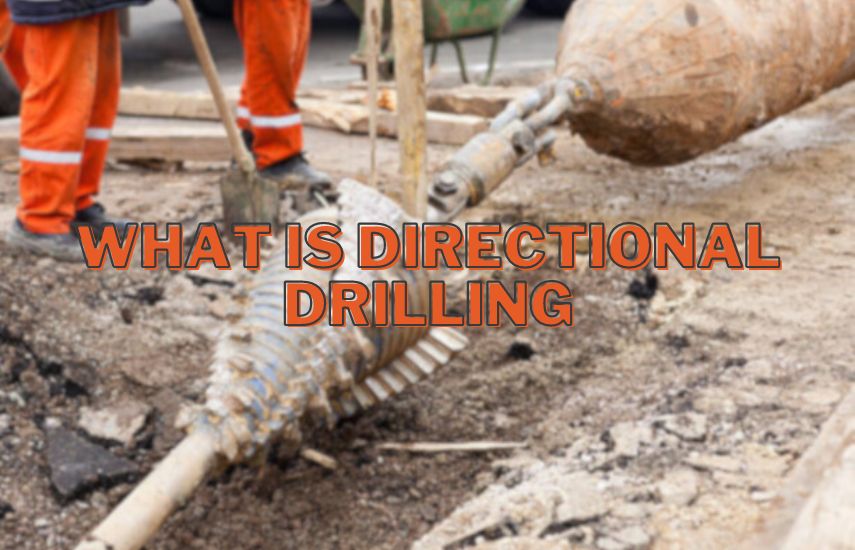Have you ever wondered how oil and gas companies are able to extract resources from deep beneath the earth’s surface without disrupting the surrounding environment? Well, the answer lies in directional drilling. This innovative technique has revolutionized the way drilling is done by allowing operators to steer the drill bit in a specific direction, giving them greater control and accuracy.
What Is Directional Drilling? Directional drilling is a drilling technique used in the oil and gas industry to intentionally deviate the wellbore from vertical to follow a desired path and reach the target zone. This technique involves the use of specialized equipment and advanced technologies to drill at various angles and navigate through complex geological formations.
If you’re curious about how directional drilling works and the benefits it offers, you’ve come to the right place. In this blog, we’ll explore the ins and outs of directional drilling and why it’s an essential technology for the oil and gas industry.
Principles of Directional Drilling
Directional drilling is a specialized technique used in the oil and gas industry that allows the drilling process to be steered in a specific direction, as opposed to traditional vertical drilling. This innovative method is used to reach oil and gas reserves that would be otherwise inaccessible with traditional drilling techniques. We will discuss the principles of directional drilling and explore its key components.
Understanding the drilling process
The process of directional drilling involves drilling a well at an angle to the vertical axis. This allows the drilling process to reach oil and gas reservoirs that are located beneath obstacles such as mountains, lakes, and urban areas.
The drilling process begins by creating a pilot hole, which is a small diameter hole drilled to a specific depth. Once the pilot hole is established, a drill bit is attached to the bottom of the drill string and guided through the pilot hole to the desired direction.
Overview of directional drilling techniques
Directional drilling techniques can be divided into two main categories: rotary steerable systems (RSS) and mud motor systems. In RSS, the drill bit is rotated and steered using a downhole motor that allows the drill string to be guided through the pilot hole.
Mud motor systems, on the other hand, use the hydraulic pressure generated by the drilling mud to turn the drill bit and steer the drill string. Both techniques offer unique advantages and are used based on the specific drilling conditions.
Types of drill bits used in directional drilling
The type of drill bit used in directional drilling depends on the specific geological conditions of the drilling site. The two main types of drill bits used in directional drilling are PDC (polycrystalline diamond compact) and TCI (tungsten carbide insert) drill bits.
PDC drill bits are ideal for drilling soft to medium-hard formations, while TCI drill bits are used for drilling hard formations such as granite and basalt. Other types of drill bits include diamond-impregnated drill bits, tricone drill bits, and hybrid drill bits, which are designed to handle a wide range of drilling conditions.
In conclusion, directional drilling has revolutionized the oil and gas industry by enabling drilling in inaccessible locations and improving the overall efficiency of the drilling process. The principles of directional drilling, including the drilling process, drilling techniques, and types of drill bits, are crucial to the success of any directional drilling project.
Advantages of Directional Drilling

Directional drilling is a modern drilling technique that involves the drilling of non-vertical wells, allowing access to previously hard-to-reach reserves. This method involves drilling at an angle to the target formation rather than drilling straight down. Directional drilling has numerous advantages, making it a popular choice among the oil and gas industry.
Enhanced Oil and Gas Recovery
One of the main advantages of directional drilling is the increased efficiency of oil and gas recovery. By drilling at an angle, the wellbore can access more of the reservoir, increasing the area of production. Directional drilling also allows for the placement of multiple horizontal wells within a single reservoir, which can further increase production rates.
Reduced Surface Impact
Directional drilling has significantly reduced the surface impact of drilling operations. With this method, fewer wells are needed to access the same amount of resources, which means less land disturbance and fewer surface facilities. Directional drilling can also reduce the number of road and pipeline crossings, minimizing environmental impact.
Accessing Hard-to-Reach Reserves
Directional drilling has made it possible to access oil and gas reserves that were once considered too difficult or expensive to produce. With this method, wells can be drilled beneath lakes, rivers, and other obstacles, making it possible to reach reserves that were previously out of reach. This has opened up new opportunities for exploration and production, particularly in offshore environments.
Minimizing Drilling Risks
Directional drilling has also helped to reduce the risks associated with drilling. With this method, wells can be drilled away from hazardous areas such as fault lines, underground caverns, and unstable formations. This reduces the likelihood of accidents and helps to ensure that drilling operations are carried out safely and efficiently.
In conclusion, directional drilling is a game-changer in the oil and gas industry, providing numerous advantages over traditional drilling methods. From enhanced oil and gas recovery to reduced environmental impact, this technique has revolutionized the way that oil and gas resources are accessed and produced.
Directional Drilling Technologies
Directional drilling is a technique used in the oil and gas industry to extract hydrocarbons from beneath the earth’s surface. It involves drilling a wellbore at an angle to the vertical axis, allowing access to oil and gas reserves that are not reachable with traditional vertical drilling.
Directional drilling technologies play a crucial role in this process, enabling the drill bit to navigate through complex geological formations with accuracy and efficiency. We will discuss some of the key directional drilling technologies, including measurement-while-drilling (MWD) systems, logging-while-drilling (LWD) tools, rotary steerable systems (RSS), and downhole motor systems.
Measurement-while-drilling (MWD) systems
Measurement-while-drilling (MWD) systems are an essential technology in directional drilling. These systems allow for real-time monitoring of the wellbore as it is being drilled, providing crucial information on the drill bit’s location, orientation, and trajectory.
MWD systems use various sensors to measure parameters such as temperature, pressure, and vibration, and transmit this data to the surface. This information is used to adjust the drilling trajectory to ensure that the wellbore stays on course and reaches its target.
Logging-while-drilling (LWD) tools
Logging-while-drilling (LWD) tools are another critical technology in directional drilling. These tools enable the measurement of formation properties, such as porosity, permeability, and rock type, while drilling is ongoing. LWD tools use various sensors, such as gamma ray detectors and resistivity sensors, to gather data about the rock formations as the drill bit passes through them.
This information is used to optimize the drilling process and to make informed decisions about the placement of completion equipment.
Rotary steerable systems (RSS)
Rotary steerable systems (RSS) are advanced drilling technologies that enable the directional control of the drill bit. RSS uses sophisticated steering mechanisms to navigate the wellbore, allowing for accurate placement of the wellbore and access to reserves that would otherwise be unreachable.
RSS systems use downhole sensors to measure the orientation of the drill bit and adjust the steering mechanism accordingly. The result is a more accurate and efficient drilling process.
Downhole motor systems
Downhole motor systems are another key technology in directional drilling. These systems use a downhole motor to drive the drill bit, rather than relying solely on the rotation of the drill string from the surface. Downhole motor systems enable drilling in challenging formations, such as hard rock or shale, and can improve drilling efficiency by reducing the wear and tear on the drill bit.
Downhole motor systems are often used in conjunction with other directional drilling technologies, such as MWD and LWD, to maximize efficiency and accuracy.
Types of Directional Drilling Techniques

Directional drilling is a specialized drilling technique that enables drilling wells at non-vertical angles. This technique has become increasingly popular in the oil and gas industry due to its ability to reach previously inaccessible reserves and increase production rates. We will explore the different types of directional drilling techniques and their applications.
Horizontal Drilling
Horizontal drilling is a directional drilling technique that involves drilling the wellbore horizontally instead of vertically. This technique is used to access reservoirs that are located at a shallow depth but are spread over a large area. By drilling horizontally, the wellbore can intersect more of the reservoir, which leads to higher production rates.
Multilateral Drilling
Multilateral drilling is a technique used to drill multiple lateral branches from a single wellbore. This technique is used to access multiple reservoirs that are located in different directions from a single well. Multilateral drilling can also be used to increase the productivity of a single reservoir by accessing it from multiple points.
Extended Reach Drilling (ERD)
Extended Reach Drilling (ERD) is a directional drilling technique used to access reservoirs that are located at a long distance from the drilling location. This technique involves drilling a wellbore with an extended reach to access the reservoir. ERD is typically used to access offshore reserves or to drill from an onshore location to an offshore reservoir.
Underbalanced Drilling
Underbalanced drilling is a technique used to drill wells with a lower pressure in the wellbore than the formation pressure. This technique is used to reduce formation damage and increase production rates. Underbalanced drilling is typically used in reservoirs with high permeability, where conventional drilling techniques may damage the reservoir.
Directional drilling techniques have revolutionized the oil and gas industry by allowing access to previously inaccessible reserves and increasing production rates. Horizontal drilling, multilateral drilling, extended reach drilling, and underbalanced drilling are some of the most common directional drilling techniques used in the industry.
Each of these techniques has its unique advantages and applications, and selecting the right technique depends on the specific characteristics of the reservoir being drilled.
Applications of Directional Drilling
Directional drilling is a drilling technique that involves drilling non-vertical wells to reach hydrocarbon reserves. This technique has revolutionized the oil and gas industry by enabling exploration and production in areas that were previously inaccessible. We will discuss some of the major applications of directional drilling.
Drilling in environmentally sensitive areas
Drilling in environmentally sensitive areas, such as national parks, wildlife reserves, and wetlands, requires a high degree of precision to minimize the impact on the ecosystem. Directional drilling has emerged as a preferred technique in such areas, as it enables operators to drill at a distance from the sensitive areas and still reach the desired targets. This reduces the surface footprint of drilling operations and minimizes the risk of environmental damage.
Offshore drilling and subsea wells
Offshore drilling and subsea wells present unique challenges due to their location in deep waters and harsh environments. Directional drilling is essential in these situations as it allows operators to drill wells at specific angles and depths, enabling them to access reserves that would be difficult or impossible to reach with conventional vertical drilling. This technique also reduces the number of wells needed to develop a field, minimizing the overall environmental impact.
Shale gas and tight oil reservoirs
Shale gas and tight oil reservoirs are unconventional sources of hydrocarbons that require specialized drilling techniques. Directional drilling is crucial in these reservoirs as it allows operators to drill horizontal wells and access the tight rock formations where the hydrocarbons are trapped.
This technique enables the recovery of previously inaccessible reserves, which has contributed to the recent surge in shale gas and tight oil production. Directional drilling in these reservoirs can reduce the surface impact and increase the efficiency of the well by enabling longer wellbores.
Challenges and Solutions

Directional drilling has revolutionized the oil and gas industry, enabling operators to access reservoirs that were once inaccessible with traditional vertical drilling techniques. However, directional drilling comes with its own set of challenges that must be addressed to ensure successful drilling operations.
We will discuss some of the challenges associated with directional drilling and the solutions that have been developed to overcome them.
Hole Cleaning and Wellbore Stability
One of the most significant challenges associated with directional drilling is maintaining hole cleaning and wellbore stability. As the drill bit progresses through the formation, it generates cuttings that must be removed from the wellbore to prevent clogging and damage to the formation. If cuttings are not removed efficiently, they can accumulate in the wellbore and impede the drilling process.
To address this challenge, various hole-cleaning technologies have been developed, such as the use of specialized drill bits that generate less cuttings or drilling fluids that can carry cuttings out of the wellbore. Wellbore stability can be maintained through the use of drilling muds that stabilize the formation and prevent collapse or sloughing.
Managing Drilling Vibrations
Drilling vibrations are another significant challenge associated with directional drilling. Vibrations can result in premature tool failure, reduced drilling efficiency, and even wellbore instability. Vibrations can be caused by various factors, such as drill string resonance, bit design, and formation characteristics.
To mitigate the impact of drilling vibrations, several solutions have been developed, such as the use of shock subs to absorb vibrations and improve tool life. Drilling parameters such as weight on bit, rotary speed, and fluid flow rate can be optimized to reduce vibrations. Advanced monitoring systems can also be used to detect and analyze vibrations in real-time, allowing operators to take corrective action quickly.
Conclusion (What Is Directional Drilling)
Directional drilling is a method used to drill non-vertical wells in the oil and gas industry. The process involves drilling at an angle, horizontally or in a curved path, to reach the target formation. This technique allows access to areas that cannot be reached by vertical drilling, making it a valuable tool for the industry.
Directional drilling has become an increasingly vital technique in the energy industry, offering an array of benefits compared to traditional vertical drilling methods. We have explored the fundamentals of directional drilling, its advantages, and its applications across various industries.
However, the significance of directional drilling goes far beyond its immediate benefits. The impact of this innovative drilling technique on the energy industry has been immense, leading to a transformation in exploration and production methods.
As directional drilling continues to evolve with advancing technology, it holds the potential to unlock even more resources and revolutionize the energy sector. We will delve into the impact of directional drilling on the energy industry and discuss the ongoing advancements in drilling technology that will shape its future.









